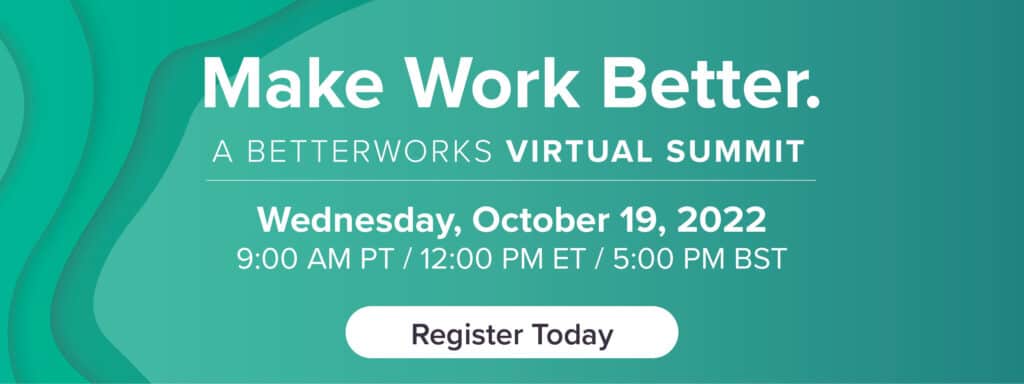Kristen Robinson is a member of the Betterworks Future of Work Advisory Council. She most recently served as chief people officer at Splunk and serves as a director and compensation committee member of Verint, a customer engagement and data analytics platform.
We’re at a moment of opportunity where we can rethink work culture and transform it into a collaborative community. It’s an important moment because we are “in between” — a time of transition when we have choice. We didn’t have much choice at the beginning of the pandemic in 2020 when many of us were forced by external circumstances to work from home. We quickly created new norms and developed new skills. We were resourceful and agile and made it work. Some felt like we didn’t miss a beat. Some said we became way more productive.
Be intentional about recreating a culture of work
Today, in the last quarter of 2022, the overwhelming and abrupt force of the pandemic has diminished; we are not victims of circumstance. There are signs that the “Great Resignation” is plateauing according to Dr. Anthony Klotz, who originally coined the term. As he explained in his recent webinar with Betterworks, while work is still unsettled, now is the best time to pursue change because employees are open to trying new things.
We can be very intentional as we choose our own path of recreating a twenty-first century culture of work that is more humanistic and other-centered. As HR leaders and other executives deliberate over how we work together now after more than two years of working virtually, the decision is about much more than where we work, how often we come to an office, and what we do there when we do come in. It’s easy to approach this in a very transactional, rule-based manner. Instead, we can consider it an opportunity to creatively re-envision and reorient the culture of work. This approach will take more thinking, more innovation, more undoing of the past ways that we think are still correct.
“As we ponder the new norms of work and the practical use and purpose of the work space, perhaps we start with principles of collaboration and community at the core of our culture.”
Kristen Robinson, Advisory Council Member, Betterworks
Why we’re moving to a more authentic work culture
Through the pandemic we learned that autonomy was powerful. When we gave people flexibility and choice, they felt like they had a degree of control amid uncertainty. This created some clarity, even if it meant having your two-year old daughter on your lap blowing kisses to all the other people in the meeting on the screen. Situations like this also led to more compassion in the workplace. They made everyone human and created shared experiences, including with top executives who also had kids interrupting at times. We got to meet family members, including pets, and saw the artwork people had on their walls, the tricycles, and the cat litter box in our colleagues’ makeshift workspaces in their garages. Surprisingly, despite not being physically together, this generated an interesting and more people-centered work environment in many ways — as long as we took a moment to notice and acknowledge it.
Pursuing a culture of collaboration
Let’s expand on these ideas — flexibility, choice, and being people-centered — and think about how they can be important elements of a lasting new culture of work. Making my own choices gives me a sense of security, self-determination, and perhaps more confidence. It allows freedom to pursue and share new ideas and insights. Not only does this autonomy lead to higher individual engagement, but it can be a foundation for better collaboration among people in an organization, which is essential today.
Collaboration takes time and has gotten a bad rap in recent years. Too much collaboration, typically measured in how many meetings we attend, slows things down. It can create confusion, be exhausting, and prevent us from having the time to reflect quietly and deeply on important topics. But our world and the problems we are attempting to solve are too complex for individuals to tackle on their own, especially leaders, who must create an environment where diverse perspectives and skills, as well as specialized knowledge, flow freely throughout the organization unimpeded by knee-jerk solutions or exclusive practices.
Enabling a culture of balance and reflection
A complement to active collaboration, which I have come to believe is equally important and woefully missing in our go-go-go work world, is time for reflection. David Rock and his colleagues call this “downtime — disconnecting for integration and insight” — in their 2012 article, “The Healthy Mind Platter.” Among the seven essential daily activities prescribed are “time in” for reflection, downtime, connection, and focus time to zero-in on tasks in a goal-oriented way. Every day our world presents so many stimuli, and as business leaders, we feel compelled to react to almost everything in some way, as fast as possible. If we create productive ways to slow down just a tad, reflect, take time to seek out and generously listen to the diverse views that come from working together, our solutions may become that much more effective and enduring. We need to foster this type of environment not just for leaders but for all employees.
Building a culture of community
Encouraging flexibility and choice does not mean letting every person in an organization do what they want. And being people-centered takes more than just being nice and caring about each other. It requires purposefully creating community: intentionally setting the robust context for a clear common purpose and mission, activated values, and shared goals and objectives that are agreed on and committed to at the organizational, team, and individual level. Breaking down silos, and diminishing hierarchy and top-down decision making are also key, along with tossing out labels, stereotypes, and biases. By doing so, we can nurture a deep sense of belonging in everyone in the community.
“If we create productive ways to slow down just a tad, reflect, take time to seek out and generously listen to the diverse views that come from working together, our solutions may become that much more effective and enduring.”
Kristen Robinson
The value of collaborative community
As we ponder the new norms of work and the practical use and purpose of the work space, perhaps we start with principles of collaboration and community at the core of our culture. We solve for those attributes when we invent new practices for the organization and when we redesign gathering places (otherwise known as offices). We prioritize autonomy, flexibility, and choice, which means that people across the organization have more say and more at stake because we have encouraged their participation. We declare what is important to us as a community and hold ourselves accountable for achieving that.
Good intentions do not create lasting culture change, though. We must pursue this quest with rigor and discipline and a variety of methods. An authentic desire to shift our mindset is the starting point. We can aim for radical transparency across the organization so that people know what’s going on and can offer their own relevant contributions. We commit to openness to hearing diverse and divergent views and to pausing long enough to reflect before we react. We make commitments to each other and our stakeholders in a disciplined way and honestly account for our progress, successes, and failures. And, we harness sophisticated technology to facilitate much of this with a focus on “people experiences” at the center.
We tend to like definition, structure, process, and sequence. That’s all important. But those things can be too static for today’s dynamic world. With collaboration and community at our core, we embrace a more organic, fluid, natural, and resilient approach with people at the center.
To learn more about how Betterworks is helping companies think anew about culture and improving workforce engagement and productivity, please join us for our Make Work Better Summit on October 19, 2022.





